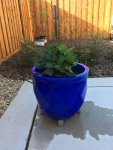Hi,
I am new to hydrangea and recently got a hold of this one from a local nurseries.
I am in zone 9b in California and before I purchase the hydrangea (the only plant my husband asks for within all the rest of “my” plant purchase; he wants a blue one), I did lots of research how to keep it blue and how in general hydrangea don’t like to much sun as it might burn (I think YouTube “garden answers” says she put an umbrella out the first year, but her weather is different from mine and hers was jumbo big and not compact type).
The specific one I got (link at the bottom) says part sun to sun sun, so I am not sure if the current set up of direct sun of 3.5 hours in spring time is sufficient enough.
Anyone has experience with this plant in hot climate or in general what to look for to tell if this plant is happy & healthy (like indicator of too much or not enough sun)?
I have attached a picture, so basically the left fence blocks the sun available in case it burnt. The pot is heavy.
Thanks in advanced.
 www.provenwinners.com
www.provenwinners.com
I am new to hydrangea and recently got a hold of this one from a local nurseries.
I am in zone 9b in California and before I purchase the hydrangea (the only plant my husband asks for within all the rest of “my” plant purchase; he wants a blue one), I did lots of research how to keep it blue and how in general hydrangea don’t like to much sun as it might burn (I think YouTube “garden answers” says she put an umbrella out the first year, but her weather is different from mine and hers was jumbo big and not compact type).
The specific one I got (link at the bottom) says part sun to sun sun, so I am not sure if the current set up of direct sun of 3.5 hours in spring time is sufficient enough.
Anyone has experience with this plant in hot climate or in general what to look for to tell if this plant is happy & healthy (like indicator of too much or not enough sun)?
I have attached a picture, so basically the left fence blocks the sun available in case it burnt. The pot is heavy.
Thanks in advanced.
Let's Dance® Blue Jangles® - Reblooming hydrangea - Hydrangea macrophylla | Proven Winners
Proven Winners - Let's Dance® Blue Jangles® - Reblooming hydrangea - Hydrangea macrophylla blue pink purple flower color varies based on soil ph plant deta...


